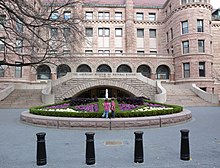|
Milford pink granite
Milford pink granite, also known as Milford granite or Milford pink is a Proterozoic igneous rock located in and around the town of Milford, Massachusetts, covering an area of approximately 39 square miles (100 km2), as mapped by the USGS. It is also sometimes referred to as Braggville granite, for several quarries in the neighboring village of Braggville, Massachusetts.[2] From 1870 to 1940, the town of Milford became famous for the "pink" variety of this stone, prized as a building material. According to local legend, the granite was "discovered" in the early 1870s by two brothers, James and William Sherman at Rocky Woods in Milford.[3] At its peak, over 1,000 men labored in dozens of quarries in Milford and nearby Hopkinton. A sample of Milford Pink is on display at the Smithsonian Institution.[4] Milford pink granite is quarried by the Fletcher Granite Company, at their Lumber Street quarry in Hopkinton.[5] Description The granite is described as a light gray or light pinkish-gray to a medium, slightly pinkish or pinkish and greenish-gray biotite granite with spots from 0.2 to 0.5 inches (5.1 to 12.7 mm) across and in some cases tapering out to 1 inch (25 mm) in length.[1] The biotite is typically in clots or short streaks. It is commonly locally gneissic.[6] The color of the stone is governed mainly by its feldspars, pink from the potash and green from the soda lime feldspar.[1] Examples of use  
See alsoReferences
External links |
||||||||
